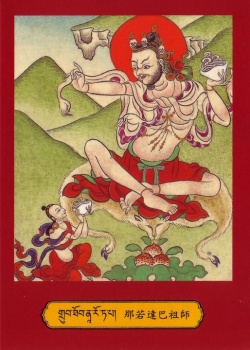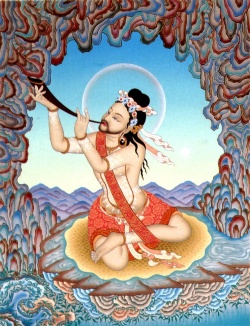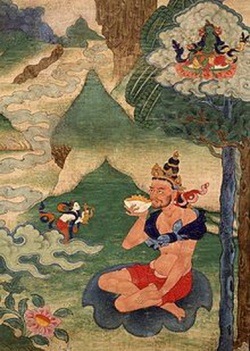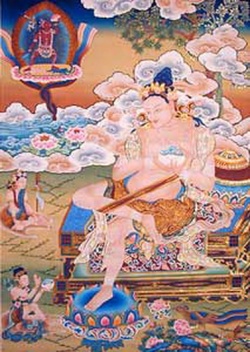Mahasiddha Naropa
According to 'The Wand that Opens the Eyes and Dispels the Darkness of Mind' (the abridged collection of biographies of the successive Gyalwang Drukpas), Naropa was born around AD 956 and passed away around AD 1050. However, other sources record him as living between AD1016 and 1100. Naropa was born in the small kingdom of Bengal. His father was a royal chieftain of an area named Shantivarman and his mother was called Srimati. His yearning for spiritual development was so strong that, when he was eight years old, he journeyed to Kashmir (one of the main seats for Buddhist studies in historical times) in order to study with the master Gaganakirti. It was from Gaganakirti that he received his lay ordination.
Naropa remained in Kashmir for three years, learning Buddhist teachings and philosophies from many great masters. By the end of his stay there he was an erudite scholar and, upon returning home, already had a number of students following him as their master.
Tilopa (an ancient mural in Hemis Monastery, Ladakh)Three years after his return from Kashmir, Naropa was forced by his parents to marry a lovely Brahmin girl, Vimaladipi (also known by her caste name, Niguma). Although they were happily married, Naropa's ardent wish to live a full spiritual life in a monastic environment became increasingly strong and Niguma also began to take spiritual practice seriously. After eight years of marriage, the couple decided to divorce and take ordination orders. Later, Niguma became one of Naropa's most advanced disciples and a devoted spiritual companion; she served Naropa when he lived in Pullahari, Kashmir.
After the divorce, Naropa went to the hermitage of Anandarama, where he was ordained as a novice by Abbot Buddhasarana and the guru Jnanaprabha, with whom he stayed for three years, mastering various Mahayana and Tantrayana philosophies. He then stayed in Pullahari for six years and wrote several commentaries on Guhyasamajatantra, Abhidharma-uttaratantra, Samvara-udbhava and Hevajratantra and composed many other works based on the Buddha's teachings. Pullahari later became an important pilgrimage site in the Tibetan Buddhist tradition, because it was one of the places where Marpa received instructions from Naropa.
The cave along a river in Mandi, where Naropa met Tilopa, his destined guruWhere Naropa flew up into the sky, in the six bone ornaments offered by Dakini (Sani Monastery, Zanskar)After his stay in Pullahari, Naropa went to Nalanda University, where his wisdom, oratory skills and spiritual understanding earned him the chancellorship of the university. He also became the 'Northern Gatekeeper'. Throughout his eight years' residence at Nalanda he was constantly faced with difficult debates with the Tirthikas, but was regularly victorious in these. At this time, he was known as Mahapandita Ahbaya Kirti (Tib. Jigme Dragpa).
Naropa's years at Nalanda were mostly engaged in intellectual activities until an old and ugly woman - who was in fact a manifestation of Vajra Yogini - appeared before him and made him realize that he was not managing to break through his spiritual misconceptions and misunderstandings. She pointed out that he should look for his destined guru Tilopa if he wished to attain Ultimate Liberation. As a result of this meeting Naropa left Nalanda, searching earnestly for Tilopa - a great master who could lead him to realize the ultimate nature of his own mind.
Traveling eastward, Naropa finally met his destined root guru, who instantly put him through difficult tests. Naropa experienced twelve major and twelve lesser hardships in order to purify his karma and emotion-induced obscurations. Through receiving great blessings from Tilopa and accomplishing his own purification, Naropa realized the clarity and harmony of mind - truly experiencing the state of Vajradhara. After attaining this magnificent realization, Naropa taught in many places and had numerous disciples, especially in Kashmir and Zanskar where he established many monasteries.
Inside this particular statue of Naropa is the golden Vajradhara statue (Sani Monastery, Zanskar)Dzongkhul Monastery, where Naropa meditated (Zanskar)According to His Holiness the Twelfth Gyalwang Drukpa, Sani is also the place where Naropa flew up into the sky upon attaining enlightenment whilst wearing the renowned Six Bone Ornaments. Naropa meditated in a small hut facing the Kanishka stupa and taught the people of Sani for a number of years. When it was time for Naropa to leave, the local people sincerely begged him to stay.
Naropa took out a golden Vajradhara statue from the hair knot on his crown and said, "There is no difference between Vajradhara and me. Venerate this statue of Vajradhara just as you are venerating me and you will get the same blessing."
Naropa left after handing over the golden statue to the local people; today, this is kept in the heart of a very special Naropa statue, which is unveiled once a year in late July on the eve of the Naro-Nasjal festival. People from all over the Zanskar valley participate in this festival, at which time monks from the Drukpa Bardan Monastery perform mask dances as well as ritual offerings.
The arrow used by Naropa, Dzongkhul Gompa, ZanskarNaropa spent twelve years serving his guru Tilopa until the latter's death. Naropa himself was said to live until AD1050 or 1100 (according to the different sources) and then resurrected into light, leaving no physical remains. Tilopa and Naropa are both recognized as two of the eighty-four great mahasiddhas in the history of Buddhism.
Amongst Naropa's accomplished disciples was Marpa, the translator, who succeeded Naropa in the lineage and brought the teachings and transmissions in their entirety to Tibet.
The origin of the Six Ornaments of Naropa goes back to the eleventh century. At this time, the Tibetan translator Marpa Choekyi Lodro of Lhodrak visited India three times and Nepal four times, encountering hundreds of erudite and accomplished Masters.
His principal Gurus were the learned Naropa and Lord Maitripa from whom he received the complete empowerments, and the essential instructions that contain the ultimate meaning of all the Sutras and Tantras. Under these Masters, he also studied the extraordinary teachings of Mahamudra and the Six Yogas of Naropa. By perfectly accomplishing those practices, he obtained full and ultimate realization.
The crown ornament of NaropaHis Holiness Gyalwang Drukpa putting on the Six Ornaments of Naropa for the second time (Ladakh, 1992)Finally, Lord Naropa declared to Marpa: "The blessings of Master Krishnacharya breathed life into the lineages of Eastern regions, the Master Aryacharya has blessed the lineage of the South, and the King Indrabhodi transmitted his spiritual influence to the Western lineages. I bestow the waves of grace to the lineages of the North, the Lands of Snow. You have nothing more to do here - return to Tibet. I impart to you the power of my legacy; I appoint you my regent on the Roof of the World. The Land of Snow abounds in potential disciples, worthy vessels for my teachings."
Following this declaration, Lord Naropa offered to Marpa the bone ornaments, which he was wearing and his rosary of rubies, as well as other ritual objects. Lord Naropa laid his noble hands upon the head of his regent Marpa, blessed him and gave him more instructions and then left to engage in victorious activity in all directions, beyond mundane existence.
Thus the Lord Marpa returned to Tibet. He released there the essence of the teachings, turning the wheel of ultimate truth for innumerable amount of students. Amongst his disciples were 'The Four Major Spiritual Sons' to whom he fully transmitted the four streams of oral instructions which he held.
One of these four great disciples was a sage inclined to give harmoniously flowing and ample explanations, like pearls of a necklace. His name was Ngokton Choku Dorje (1036-1102) and to him Marpa gave the particular transmission of the four classes of Tantras: root texts, sadhanas, essential commentaries and instructions. Marpa also entrusted him with the ritual objects which were the supports for the practice of Naropa and his Six Ornaments, announcing to Ngokton in a prophetic manner, " Keep these. Now for your forthcoming descendents, until the seventh generation, simply knowing how to hold vajra and bell will be sufficient for the Master himself to bestow the waves of grace."
His Holiness putting on the Six Ornaments of Naropa for the third time (July 2004)As he had prophesized, the Six Sacred Ornaments remained the possession of the Masters of the lineage of Ngok until the advent of the seventh generation, and they were venerated as devotional support.
Then came the time when the Seventh Ngok, Ngokton Jangchub (1360-1446), encountered the Gyalwang Drukpa - Kunga Paljor, the Second Incarnation. Ngonton Jangchub then granted the Gyalwang Drukpa the totality of the teachings transmitted in the lineage of Ngok, and offered him the Six Ornaments and the initiation vase of Lama Ngok, amongst other treasures. By proclaiming him holder of his teachings, he finally declared: "The Dharma returns in the hands of its Sovereign!" and he then announced that the Victorious Dragon was the Incarnation of the Lord Naropa.
Since then the incarnations of the Gyalwang Drukpa have successively inherited the Ornaments, which they kept as devotional support. The Gyalwang Drukpa offered them for viewing so that those fortunate beings who see them may accumulate merit.



